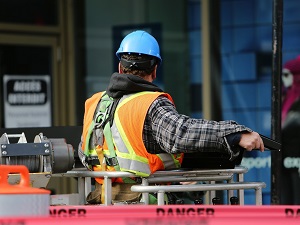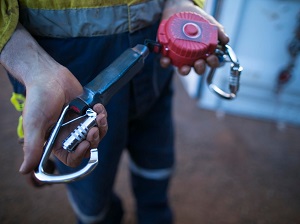Fall hazards are recognized as one of the OSHA Big Four which account for the majority of fatalities in the construction industry. Personal Fall Arrest Systems are a common type of protection used by workers when serious fall hazards exist in their working environment.

What is a Personal Fall Arrest System?
A personal fall arrest system, also known as PFAS, is a system used to safely stop (arrest) a worker who is falling from a working level. It consists of an anchor point, a connector, and a body harness.
When a personal fall arrest system is chosen as the means of fall protection on a job site, the PFAS must:
- Limit the maximum arresting force on a worker to 1,800 pounds when used with a body harness.
- Be rigged so that a worker can neither free fall more than 6 feet nor contact any lower level.
- Bring a worker to a complete stop and limit the maximum deceleration distance a worker travels to 3.5 feet.
- Have sufficient strength to withstand twice the potential impact energy of a worker free falling a distance of 6 feet or the free fall distance permitted by the system, whichever is less.
- Be inspected prior to each use for wear, damage, and other deterioration. Defective components must be removed from service.
OSHA Standard 1926.502(d)(16)(iii) Personal fall arrest systems, when stopping a fall, shall be rigged such that an employee can neither free fall more than 6 feet, nor contact any lower level.

Fall Protection Training
Thorough employee training in the selection and use of personal fall arrest systems is imperative. Careless or improper use of the equipment can result in serious injury or death. Workers must be trained in the safe use of the system including:
- how to put on harnesses correctly
- limitations of the fall protection equipment
- proper anchoring and tie-off techniques
- estimation of free fall distance, including determination of deceleration distance, and total fall distance to prevent striking a lower level
- methods of use
- how unique conditions at the worksite may determine what type of system to use
- inspection and storage of the system
OSHA Standard 1926.503(a)(1) The employer shall provide a training program for each employee who might be exposed to fall hazards. The program shall enable each employee to recognize the hazards of falling and shall train each employee in the procedures to be followed in order to minimize these hazards.
Fall Arrest System Inspections
The wearer should inspect their personal fall arrest system equipment before every use and keep a written record of the inspection. During a PFAS inspection, look for worn, damaged or defective components.
If there is any doubt about the safety of the equipment, do not use it. Replace any defective equipment before using the system. Any equipment, including ropes, that have been involved in a fall should be removed from service.
OSHA Standard 1926.502(d)(21) Personal fall arrest systems shall be inspected prior to each use for wear, damage and other deterioration, and defective components shall be removed from service.
Any component with any significant defects must be withdrawn from service immediately, tagged or marked as unusable, or destroyed. During the PFAS inspection, look for:
- cuts, tears, abrasions, mold, or undue stretching
- alterations or additions which might affect its efficiency
- damage due to deterioration
- contact with fire, acids, or other corrosives
- distorted hooks or faulty hook springs
- tongues unfitted to the shoulder of buckles
- loose or damaged mountings
- non-functioning parts

Planning a Fall Arrest System
One of the most important aspects of fall arrest systems is fully planning the system before it is put into use, and this includes planning for a suitable anchor point. Before use, a qualified person should evaluate the anchor points with a focus on proper strength. Examples of anchor points include:
- Steel members or l-beams, if an acceptable strap is available for the connection (do not use a lanyard with a snaphook clipped to itself)
- Large eye-bolts made of an appropriate grade steel
- Guardrails or railings if they have been designed for use as an anchor point
- Masonry or wood members, if the attachment point is substantial and precautions have been taken to assure that bolts or other connectors will not pull through
- Other properly planned anchorages designed by a professional engineer or qualified person
Instead of connecting directly to a stationary anchor point, a personal fall arrest system can connect to a lifeline instead. A lifeline is a vertical or horizontal cable or rope that connects to proper anchor points.
A rope grab (or cable grab) allows a worker to move up a vertical lifeline and will automatically engage and lock on the lifeline if the worker falls. The rope grab must be compatible with the lifeline and attached correctly (not upside down). Keep the lanyard (between the rope grab and the body harness) as short as possible and keep the rope grab as high as possible on the lifeline. Each worker must be attached to a separate vertical lifeline.

Full-Body Harnesses
Full-body harnesses come in a variety of styles that suit different work conditions. Harnesses may be configured slightly different depending on if they will be used primarily for positioning, climbing, confined spaces, or a combination of work tasks.
A full-body harness should include a D-ring on the back for attaching a lifeline or lanyard. The position of the D-ring reduces strain on the body and keeps the wearer upright in the harness during and after a fall. Some safety harnesses have additional D-rings on the shoulders, hips, or chest that allow them to be used for positioning, ladder climbing, and raising or lowering workers into confined spaces.
Harnesses may have compatible accessories like a high-visibility vest, a belt, a seat sling, or belly pad connection.
For work, only use industrial full-body harnesses, and not recreational climbing harnesses.
Follow the manufacturer’s instructions on how to care for and clean the components of the fall arrest system, including the body harness. After cleaning a PFAS, do not dry the equipment out in the sunlight for a long time, and keep the equipment away from direct heat. Store PFAS equipment in a clean, dry area, that is free of fumes, sunlight, corrosive materials, sharp edges, or vibration.

Lanyards
A lanyard is a specially designed flexible line that typically has a snap hook at each end. One snap hook connects to the body harness and the other connects to an anchor point or a lifeline. Lanyards must have a minimum breaking strength of 5,000 pounds.
Lanyards come in a variety of styles, including self-retracting types that make moving easier and shock-absorbing types with single or double legs. Never combine lanyards to increase length or knot them to make them shorter.
OSHA Standard 1926.502(d)(9) Lanyards and vertical lifelines shall have a minimum breaking strength of 5,000 pounds.
Deceleration devices, a required component of the PFAS, protect workers from the impact of a fall and include shock-absorbing lanyards, self-retracting lifelines or lanyards, and rope grabs. Never use a shock-absorbing lanyard if the shock absorber is even partially extended or if the lanyard has arrested a fall. Snap hooks must be the locking type and designed and used to prevent disengagement from any component part of the personal fall arrest system.

Weeklysafety.com encourages and promotes all companies to schedule weekly safety meetings on a variety of topics throughout the year. Safety topics can range from walking/working surfaces hazards, to electrical cord safety, to seasonal flu prevention.
.jpg)

